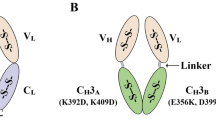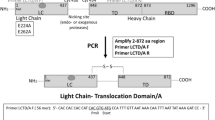Abstract
Botulinum neurotoxin serotype B (BoNT/B)-specific Fab was expressed in a cell-free protein synthesis system derived from an E. coli extract. The cell-free synthesized antibody fragment was found to be effective in neutralizing the toxicity of BoNT/B in animal studies. Expression of functional Fab required an appropriately controlled and stably maintained redox potential. Under an optimized redox condition, the cell extract, whose disulfide reducing activity had been exhausted, could generate bio-functional Fab molecules. Use of a cell extract enriched with molecular chaperones (GroEL/ES) and disulfide bond isomerases were effective in obtaining larger quantities of functional Fab. Under the optimized reaction conditions, approximately 30 μg of functional Fab was obtained after purification from 1 mL reaction mixture.




Similar content being viewed by others
References
Chadd HE, Chamow SM (2001) Therapeutic antibody expression technology. Curr Opin Biotechnol 12:188–194
Krauss J (2003) Recombinant antibodies for the diagnosis and treatment of cancer. Mol Biotechnol 25:1–17
Holliger P, Hudson PJ (2005) Engineered antibody fragments and the rise of single domains. Nat Biotechnol 23:1126–1136
de Haard HJ, van Neer N, Reurs A, Hufton SE, Roovers RC, Henderikx P, de Bruine AP, Arends JW, Hoogenboom HR (1999) A large non-immunized human Fab fragment phage library that permits rapid isolation and kinetic analysis of high affinity antibodies. J Biol Chem 274:18218–18230
Presta LG (2002) Engineering antibodies for therapy. Curr Pharm Biotechnol 3:237–256
Carter PJ (2006) Potent antibody therapeutics by design. Nat Rev Immunol 6:343–357
Kipriyanov SM, Le Gall F (2004) Generation and production of engineered antibodies. Mol Biotechnol 26:39–60
Marasco WA, Sui J (2007) The growth and potential of human antiviral monoclonal antibody therapeutics. Nat Biotechnol 25:1421–1434
Humphreys DP (2003) Production of antibodies and antibody fragments in Escherichia coli and a comparison of their functions, uses and modification. Curr Opin Drug Discov Devel 6:188–196
Hoogenboom HR (2005) Selecting and screening recombinant antibody libraries. Nat Biotechnol 23:1105–1116
Kim DM, Choi CY, Ahn JH, Kim TW, Kim NY, Oh IS, Park CG (2006) Development of a rapid and productive cell-free protein synthesis system. Biotechnol Bioprocess Eng 11:235–239
Kim TW, Oh IS, Keum JW, Kwon YC, Byun JY, Lee KH, Choi CY, Kim DM (2007) Prolonged cell-free protein synthesis using dual energy sources: combined use of creatine phosphate and glucose for the efficient supply of ATP and retarded accumulation of phosphate. Biotechnol Bioeng 97:1510–1515
Kim DM, Swartz JR (2004) Efficient production of a bioactive, multiple disulfide-bonded protein using modified extracts of Escherichia coli. Biotechnol Bioeng 85:122–129
Ryabova LA, Desplancq D, Spirin AS, Pluckthun A (1997) Functional antibody production using cell-free translation: effects of protein disulfide isomerase and chaperones. Nat Biotechnol 15:79–84
Jiang X, Ookubo Y, Fujii I, Nakano H, Yamane T (2002) Expression of Fab fragment of catalytic antibody 6D9 in an Escherichia coli in vitro coupled transcription/translation system. FEBS Lett 514:290–294
Lee MS, Lee JC, Choi CY, Chung J (2008) Production and characterization of monoclonal antibody to botulinum neurotoxin type B light chain by phage display. Hybridoma 27:18–24
Gill DM (1982) Bacterial toxins: a table of lethal amounts. Microbiol Rev 46:86–94
Kadokura H, Katzen F, Beckwith J (2003) Protein disulfide bond formation in prokaryotes. Annu Rev Biochem 72:111–135
Kim DM, Kigawa T, Choi CY, Yokoyama S (1996) A highly efficient cell-free, protein synthesis system from Escherichia coli. Eur J Biochem 239:881–886
Kang SH, Kim DM, Kim HJ, Jun SY, Lee KY (2005) Cell-free production of aggregation-prone proteins in soluble and active forms. Biotechnol Prog 21:1412–1419
Chung J, Rader C, Popkov M, Hur YM, Kim HK, Lee YJ, Barbas CF 3rd (2004) Integrin alphaIIbbeta3-specific synthetic human monoclonal antibodies and HCDR3 peptides that potently inhibit platelet aggregation. FASEB J 18:361–363
Oh IS, Kim DM, Kim TW, Park CG, Choi CY (2006) Providing an oxidizing environment for the cell-free expression of disulfide-containing proteins by exhausting the reducing activity of Escherichia coli S30 extract. Biotechnol Prog 22:1225–1228
Kim DM, Choi CY (1996) A semicontinuous prokaryotic coupled transcription/translation system using a dialysis membrane. Biotechnol Prog 12:645–649
Buechter DD, Medzihradszky KF, Burlingame AL, Kenyon GL (1992) The active site of creatine kinase. Affinity labeling of cysteine 282 with N-(2, 3-epoxypropyl)-N-amidinoglycine. J Biol Chem 267:2173–2178
Acknowledgment
This work was supported by a grant from the Basic Research Program of the Korea Science & Engineering Foundation (Grant No. R01-2007-000-20980-0).
Author information
Authors and Affiliations
Corresponding author
Rights and permissions
About this article
Cite this article
Oh, IS., Lee, JC., Lee, Ms. et al. Cell-free production of functional antibody fragments. Bioprocess Biosyst Eng 33, 127–132 (2010). https://doi.org/10.1007/s00449-009-0372-3
Received:
Accepted:
Published:
Issue Date:
DOI: https://doi.org/10.1007/s00449-009-0372-3




